Impact of Fluorescence On a Diamond’s Value And Pricing

How does fluorescence affect diamond value?
The real impact that fluorescence has on the value of a diamond is still a subject of ongoing debate. Before the 1970s and the advent of grading reports, fluorescence was the whole craze among diamond buyers because it was thought to enhance a diamond’s appearance.
At that time, these “blue-white” diamonds (colorless stones with blue fluorescence) were marketed as alternatives to fancy blue diamonds and were in higher demand than non-fluorescing diamonds. Due to supply and demand, there was a huge price premium for these diamonds.
After the FTC banned the use of the term “blue-white” and grading reports started to include details like fluorescence ratings, the consumer’s perception changed. Buyers wanted to avoid diamonds that had anything ‘extra’ listed in the grading report; be it color, fluorescence or inclusions and this started to hurt the value of “blue-white” diamonds.
Today, diamond buyers have a negative stigma towards fluorescence due to widespread misinformation about it. In fact, most consumers automatically shun away from these diamonds without any reason.
In this article, we are going to find out how fluorescence affects diamond value and how you can take advantage of getting better pricing by knowing what to look out for. Let’s dive in!
How Does Fluorescence Affect Diamond Value?
Blue fluorescence can be found in 35% of naturally mined diamonds and it makes the stone glow under UV light. Outside of UV lighting environments, there are no visual differences between fluorescent and non-fluorescent diamonds.
However, there exists a big difference in pricing between these diamonds. In the industry, diamonds with fluorescence are usually traded at a 10-15% discount and can go as high as 25% for higher colored diamonds.
Here’s a table to give you a rough idea of the discounts of different colored diamonds and their respective fluorescence strength. At the time of writing, this data was collated by comparing diamonds with similar carat size and cut quality.
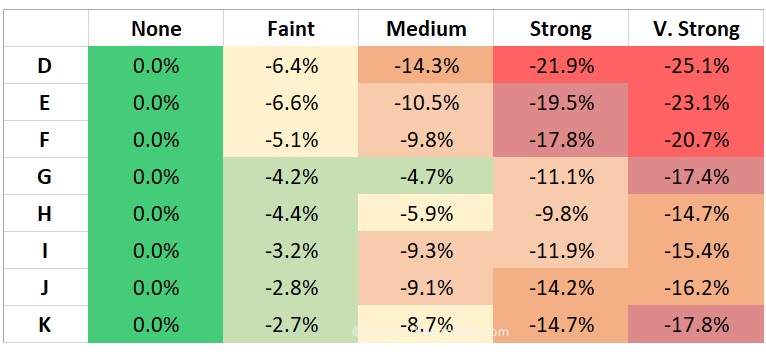
*Note that price discounts may be more pronounced with larger carat size and higher clarity.
In general, fluorescence diamonds are discounted and it doesn’t affect prices equally. When it comes to colorless (D-F) diamonds, the market “hates” fluorescence and that’s why you see the massive price differences in “Strong” and “Very Strong” levels.
While it is true that “Strong” and “Very Strong” fluorescence can cause diamonds to look hazy, it only happens to a minority of stones. Due to irrational fear, the market prices them as if fluorescence is going to make every single diamond appear cloudy.
For lower color grades, the price discounts are relatively flat across the different color brackets. Interestingly, the G and H color grades have smaller discounts for medium blue fluorescence. This is likely due to fluorescence being helpful in offsetting coloration present in near-colorless diamonds.
Real Life Price Comparison of Fluorescent Diamonds
When it comes to super ideal cut diamonds that are cut for light performance, Brian Gavin is a vendor I highly recommend. Their signature Blue line consists of carefully curated ideal cut diamonds with blue fluorescence.
If you are interested in finding out more details, feel free to read our full review about them here…
To perform a real life price comparison, we will examine how Brian Gavin’s Blue stack up against their signature hearts and arrows diamonds (without fluorescence). Here, I do want to point out that both signature lines represent the pinnacle of precision cutting for optical performances. This means we are able to keep variances in cut quality, carat size, color and clarity to a minimum.
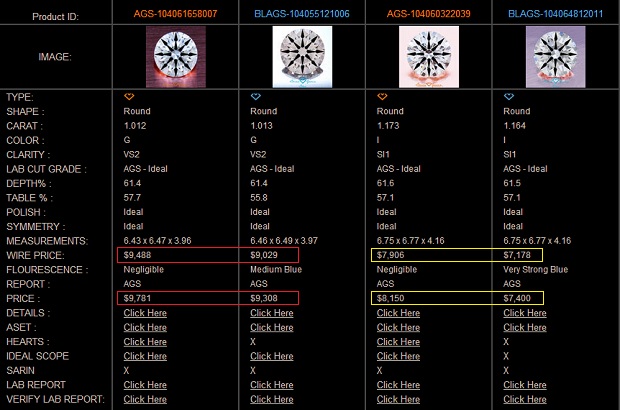
In the comparison between the 1ct G VS2 diamonds, the price difference between a medium blue and a negligible fluorescence diamond is about 4.8%. In the comparison between the 1.1ct I SI1 diamonds, the price difference is about 9.2%.
Even though the diamonds would look completely identical in a side by side comparison, the fluorescent diamonds are cheaper!
Let’s take a look at another set of diamonds with similar specifications. Again, you can see that diamonds with strong blue fluorescence cost a lot less than non-fluorescent diamonds.
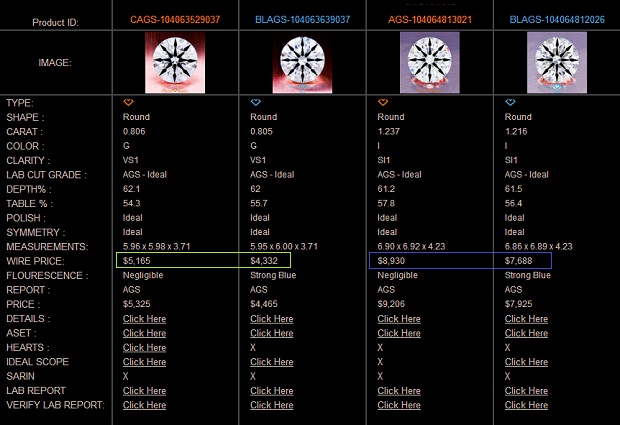
You Can Save Money by Buying a Diamond With Fluorescence!

Holding a cushion cut diamond ring in black light.
Personally speaking, I’m a huge fan of fluorescence and I think it is an extremely cool feature. Seeing a bluish glow in a diamond makes me geek out and this can probably be attributed to my previous job as a researcher.
The other reason to consider a diamond with fluorescence is for practical purposes. Not only do you get a better price point, but you can also get a whiter looking diamond with near colorless stones.
The caveat here is that you need to make sure that fluorescence doesn’t cause the diamond to look hazy.
So, where do you buy diamonds with fluorescence? The best place to shop for them is at Brian Gavin where each diamond in this Blue line is personally inspected and guaranteed to have no negative effects from fluorescence.
To sum up, fluorescence is not a big issue when shopping for diamonds if you know what to look out for. In fact, fluorescence is a fun feature because of the cool effect it has on the stone. At the end of the day, the choices you make will depend on your personal tastes.
<< Prev PageRelated Articles
Leave A Comment



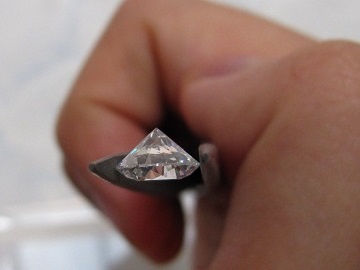
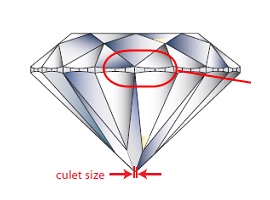









12 Comments
Hi Paul,
Thanks for the awesome website, I am interested in buying a blue fluorescence diamond, I noticed that a very strong blue and color I diamond is much cheaper than medium blue and color G, and even bigger size in your example above, may I know what is the disadvantage of the very strong blue diamond in this case? I assume they are both colorless since it’s a signature blue from Brain Gavin. Which one would you prefer?
There’s actually no disadvantage of a very strong blue fluorescent diamond from the BGD Blue line. Besides the very strong blue intensity, the prices are cheaper because of the color grade differences. I would need to see both the listing urls to review the stones before I can offer any constructive feedback.
I’m an old timer here and I remembered clearly how my jeweler tried to sell me a Type II diamond and called it a blue jager diamond. Back then, everyone was buying diamonds with very strong fluorescence and how fortunes have changed in the modern day. Thanks for the info on your site, I really enjoyed reading your website.
Historically, certain types of diamonds are given trade names based on where they are mined in large quantities.
The term Jager refers to colorless diamonds with strong blue fluorescence because they are commonly excavated from South Africa’s Jagersfontein mine. I believe this is the diamond source you are referring to.
Also, you may have come across a term called “premier”. It is used to describe light yellow diamonds with strong blue fluorescence properties because such stones often originate from South Africa’s Premier Mine.
I still cannot understand why are fluorescent diamonds worth less when they are helping diamonds look whiter. I’m looking to buy a strong blue D color diamond and I am worried that it cannot hold its value when I try to resell it in the future.
Whatever positive effect fluorescence has on a diamond seems to be of little consequence since the buyers’ perception is to automatically shun away from diamonds with fluorescence. In a market driven world, this has led to lower prices and is something you can learn to take advantage of.
Here, I want to bring up an interesting price observation I’ve come across in the trading networks. Because fluorescence can actually help improve visual color appearances, some diamonds with near colorless grades like G – J may sell at slightly higher prices if they have favorable fluorescence properties.
Now, if you are thinking about buying diamonds and reselling them in the future for a profit, please scrap the idea. You are going to take a big hit the moment you buy it at retail prices. Buy diamonds for wearing and not for investing.
Blue Jager diamond are one of the rarest diamonds. I believe the jager mining was stopped way back. There are only a few that were mined. All the blue jager available today are not the original ones which came years ago. I have seen that diamond. You should see it in sunlight it will look like blue diamonds when you look from other angles it will be crystal clear white. I was amazed after seeing that. The one I saw was mined in at the end of 18th century. It was the original BLUE JAGER. You could rarely see one like that now.
Hello,
I found this site while searching to educate myself on blue fluorescence.
I was origianlly quite upset to learn that my stone is possible of lessor value due to having this feature. Now I see that some people love it.
I have a stunning 2.4 ct emerald cut stone that I am trying to sell and if anyone is interested, they can find me and I will send images as well as the GIA info.
You can find me on LinkedIn Rachael Stevens in Los Angeles or on Instagram @JinkieJones if you have any interest.
Thank you!!
If fluorescence is only noted as “faint” on a GIA report, does that automatically mean it is faint blue, or would it have to say faint blue? Could just plain “faint” on a GIA report mean yellow, green, pink, or another color?
Unfortunately, GIA does not note the color of the fluorescence unless the diamond has medium, strong or very strong intensity of fluorescence. The color of the faint fluorescence can be anything. It can be white, yellow, red or blue but I would say that it is most likely going to be blue. So, you need to inspect the diamond under a UV light or get the vendor to give you the information. If they can’t, then you should question why they can’t and whether you should really be buying anything from them.
Hi,
Is it true that “faint fluorescence” should have no impact on a G color grade diamond? impact meaning haziness or transparency?
You are right. Faint fluorescence shouldn’t have any impact on the diamond’s appearance. If the diamond is milky or hazy, it is more of an issue with clarity rather than fluorescence.